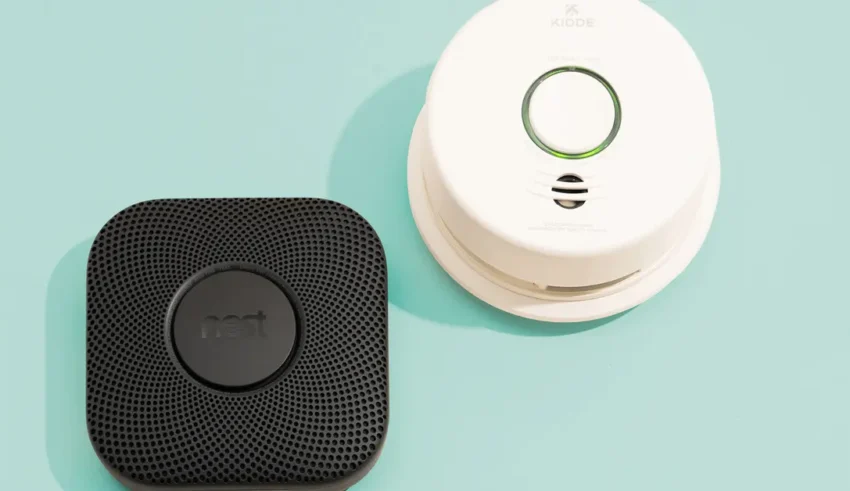
Most homes have smoke alarms. They’re on the ceilings, they beep incessantly when it’s time for new batteries, and they’re considered status quo for home safety. But there’s a second killer that’s just as fatal as fire and is often unproven in homes without the equipment to detect it, because it doesn’t belong anywhere else but in certain rooms.
The reality is that carbon monoxide kills. People die in homes that have perfectly functional smoke alarms. The two dangers are completely different, call for different detection and yet, equally require awareness in homes. Therefore, the more people know about how and why these two varieties of detection matter and how the technology exists to consolidate the two threats in one, the more equipped they feel to safeguard their homes from either crisis.
Table of Contents
Why Just Smoke Detection is Not Enough
Smoke detection is commonplace in today’s society. Buildings are required to have smoke alarms installed. They are affordable, they are easy to find, and with one major purpose, it’s clear what they do and how they function. Yet this idea that smoke detection will be found everywhere has made people feel overly confident in their protection from smoke.
Sure, a house could have multiple smoke detectors strategically placed on every level, but if it fails to detect carbon monoxide, it’s still at a major risk of death by gas. This is because smoke and CO are two completely different entities. When a house is on fire, it emits smoke that is detected by smoke alarms; it does not emit dangerous levels of carbon monoxide (at least not quickly enough) in time to warn people that CO will be the precursor to their failure. The opposite is just as true; a carbon monoxide leak from an outdated boiler, blocked flue or broken appliance occurs without any smoke at all. A person can have the best and most reliable smoke alarms in the world and still succumb to carbon monoxide poisoning because a smoke alarm can’t detect it.
It’s not hypothetical, either. Thousands of people every year in the UK suffer from CO poisoning, often in houses with perfectly functional smoke alarms. Unfortunately, these people either didn’t realize they needed dedicated CO protection for other rooms, they knew they should’ve had separate detection but never got around to it, or they had CO detection in some rooms that weren’t relevant to their deaths.
The Invisible Carbon Monoxide Nobody Sees Coming
The kicker? Carbon monoxide is completely invisible and odorless. While this sounds like a cliché, it’s completely true when it occurs in someone’s home. There is no smell. There is no vision. There is no immediate onset of discomfort. Instead, the first signs of distress occur through headaches, dizziness or nausea, symptoms easily brushed off as the flu or food poisoning. By the time someone realizes something has gone terribly wrong, they’ve succumbed to impairment where they’re too incapacitated to help themselves.
There are several appliances in any given home that can produce carbon monoxide as a byproduct of combustion. Gas boilers, gas hobs, gas fires, oil heating appliances and solid fuel stoves all produce CO by means of an intentional flame or fire combustion. Under normal circumstances, CO should be vented out through a flue. But when there’s an issue with the appliance; the flue is blocked; there is inadequate ventilation, carbon monoxide can built up inside living spaces.
This CO problem poses even greater danger than old appliances that are obviously on their last legs (think rusted but operating coal fireplaces). A modern boiler could work perfectly fine for five years until suddenly there’s a fault. A flue could be marginally blocked for years until it creates a problem. It’s not just old junk, it’s new appliances that pose problems. Yet unless there’s a CRITICAL REASON to have an alarm, an alarm, there’s no warning until symptoms occur, and by that time, people might not even recognize that they’re symptoms attributable to carbon monoxide exposure.
Why Homes Need Both Types of Detection
The reality is that as long as people understand the rationale behind each need that exists among typical homes, then wanting both types of detection isn’t an argument that needs to be made.
Instead, these two types of detection serve two different purposes that are based on basic function within a typical home. Smoke alarms alert residents to fire before it’s too late and it’s not possible to distinguish between CO leaks and gas leaks. The latter builds up so much that people are poisoned before they realize there’s an issue.
Now, whether or not both types can be achieved easily within a home is the true dilemma. The traditional means of achieving this would be to purchase one device for each hazard; place it where needed; keep two systems maintained; access two units when they need new batteries. This works, but leaves homes with reliable smoke detection and hit or miss CO detection.
Enter combination units, Combination Smoke and Carbon Monoxide Alarm which do both for the users’ convenience. One device on the ceiling does it all, one battery/plug source; one device tested regularly. The less complicated it is, the more willing people will be to achieve appropriate protection in the first place.
How Combination Units Actually Work
Combos are not just built for convenience with smoke detection and carbon monoxide sensors added afterthoughts in practical application. They’re built from necessity for both proper resolution types in functioning separately without issue from one another. The smoke sensor (usually optical or ionization) detects particles forming in air related to fire; the CO sensor (typically electrochemical) determines levels of carbon monoxide that trigger hazardous exposure.
These two functions operate seamlessly without interference from one another, meaning if there’s smoke in a home without carbon monoxide present, the unit will still go off. If there’s only carbon monoxide going off without any presence of smoke, it will still indicate two separate alarm patterns, with priority achievement over escaping first instead of figuring out which sensor went off. The point is that each threat is continuously monitored without gaps in detection, which makes combination devices well worth it.
Quality counts when talking about these special devices too; cheap knockoffs often come with cheap sensors generating false positives, or worse, failure to detect hazards at all. Premium combination devices use rely upon reliable sensors technology; plugged in with backup options; regular maintenance in the form of sealed batteries which last longer as long as it’s installed properly. Usually, premium combination units fall only £20-40 more than standard cheaper options without providing protection for what’s at stake.
Where Combination Units Make The Most Sense
While there are certain rooms where combination units work best based on both hazards exist along with accessibility for low-functioning persons needing wake ups, there are also common rooms where combinations make more sense than separate detection.
For example, bedrooms make sense for this reason; if someone gets trapped during their sleep because their head was under the covers or because they’re going breathless from an angry gas engine run overheating after 30 minutes, those people need to be awakened regardless.
Hallways/Landings represent common areas through which residents pass either to get outside or get trapped where clearer acceptance from both alarms is needed.
Kitchens create a bit of grey area for concern; cooking can create heat/smoke factors which could create annoying alarms so heat alarms are better than smoking detection, but combination smoke/CO units just outside kitchens still provide critical coverage where both hazards are realistically possible.
Near places with fuel appliances particularly benefit from CO detection combined with the potential fire source, a combination unit near a gas boiler serves dual purposes assessing the carbon monoxide risk from boiler fault OR as a potential fire risk composite natural window covering.
The Practical Advantages Beyond Just Detection
Beyond smelling or seeing improper detection, a major advantage of having combinations installed provides less installations to maintain. Six smoke alarms, four CO alarms equals ten separate devices when combination units bring fewer devices together with multiple needs served.
This matters because each alarm needs testing/battery replacement per power source monitoring; eventually they all need replacing (timeframe dependant on appropriate recommended guidelines for all safety purposes).
Aesthetics aside, no one wants their ceiling littered with tons of added effort, one or two additions per ceiling/wall looks better than five/six/ten, you don’t want your house to look cluttered on top of making efforts for life safety, it look saner that way without this other added stress.
Cost matters, even though sometimes it doesn’t matter how people assume it will. Generally, combination units cost more than basic smoke alarms, but less than purchasing both types separately. Therefore if coverage for both hazards is appropriate, combination saves overall costs for added ease operating skills.
What Combination Units Don’t Do
Combination alarms essentially don’t absolve homes from maintaining other detection elsewhere throughout their home, and other proper maintenance instead should be brought into consideration.
For example, a single combination unit does not cover an entire home as sufficed connection any more than a single smoke alarm would cover an entire home front with no protection needed elsewhere. Instead, homes still need coverage (and still can’t replace separate units despite needing only one product instead of purchased separately).
They also don’t replace maintenance of appliances; a carbon monoxide alarm response happens, it’s better if it never becomes proactive. However servicing your boilers and heating appliances keep them from forging improper connections.
Making Home Safety Actually Happen
The beauty of Combination Smoke and Carbon Monoxide Alarms is that when practical convenience appeals away from home safety options dictated by common theme’s integration, the likelihood of successful home protection becomes easier to attain.
Instead of two separate shopping trips; installations; maintenance schedules, having one unit as a connector makes purchasing/installing/maintaining safer more attractive since most people don’t want all added sensorial stress confusing them as much as essentially separating potential problems.
It’s important for homes to recognize every type of potential safety throughout their lives, not optional extras, and any technology that brings comfortable solutions together successfully makes more sense for everyone throughout their lives going forward.
It’s not optional extras, for the average home, combination units are the most practical means through which both faults can simultaneously be held responsible 24/7, even with separate considerations made elsewhere regardless along the way!














